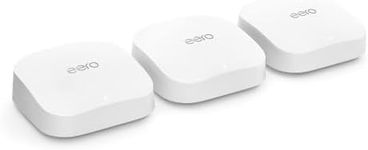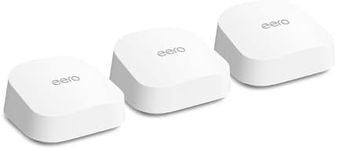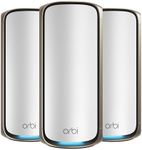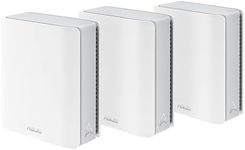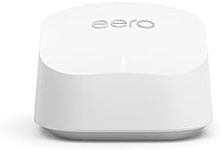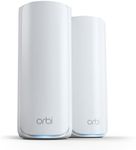Buying Guide for the Best Mesh Wifi Systems
When choosing a mesh Wi-Fi system, it's important to understand that these systems are designed to provide seamless internet coverage throughout your home or office by using multiple nodes or units. This is particularly useful in larger spaces or areas with many obstacles that can interfere with a traditional single-router setup. The goal is to ensure that you have consistent and strong Wi-Fi signals in every corner of your space. To make the best choice, consider the size of your area, the number of devices that will be connected, and any specific features you might need, such as parental controls or guest networks.Coverage AreaCoverage area refers to the total space that the mesh Wi-Fi system can effectively cover with a strong signal. This is important because it determines how well the system will perform in your home or office. Coverage is usually measured in square feet or meters. Systems are often segmented into small (up to 2,000 sq ft), medium (2,000-4,000 sq ft), and large (over 4,000 sq ft) areas. To pick the right one, consider the size of your space and any potential obstacles like walls or floors that might interfere with the signal.
Number of NodesThe number of nodes in a mesh Wi-Fi system refers to the individual units that work together to create a seamless network. This is important because more nodes can provide better coverage and handle more devices. Systems typically come with two to three nodes, but you can often add more if needed. If you have a larger home or many devices, you might need more nodes to ensure consistent coverage. Consider your space's layout and the number of devices you plan to connect when deciding how many nodes you need.
SpeedSpeed in a mesh Wi-Fi system refers to the maximum data transfer rate it can handle, usually measured in megabits per second (Mbps). This is important because it affects how quickly data can be sent and received, impacting activities like streaming, gaming, and video conferencing. Speeds are often categorized as basic (up to 300 Mbps), mid-range (300-600 Mbps), and high-speed (over 600 Mbps). Choose a speed that matches your internet plan and usage needs; for example, higher speeds are better for households with multiple users or heavy streaming.
Band SupportBand support refers to the frequency bands that a mesh Wi-Fi system can operate on, typically 2.4 GHz and 5 GHz. This is important because different bands offer different benefits; 2.4 GHz provides longer range but slower speeds, while 5 GHz offers faster speeds but shorter range. Some systems also support a third band, known as tri-band, which can help manage network traffic more efficiently. Consider your environment and usage; if you have many devices or need high-speed connections, a dual-band or tri-band system might be beneficial.
Ease of Setup and ManagementEase of setup and management refers to how simple it is to install and control your mesh Wi-Fi system. This is important because a user-friendly system can save you time and frustration. Many systems offer app-based setups and management, allowing you to control your network from your smartphone. Look for systems with intuitive apps and features like automatic updates and easy device management. If you're not tech-savvy, prioritize systems known for their straightforward setup and user-friendly interfaces.
Security FeaturesSecurity features in a mesh Wi-Fi system refer to the protections it offers against unauthorized access and cyber threats. This is important to keep your network and data safe. Common features include WPA3 encryption, automatic firmware updates, and parental controls. Some systems also offer additional security services like malware protection. Consider your security needs; if you have children or sensitive data, look for systems with robust security features and parental controls.
